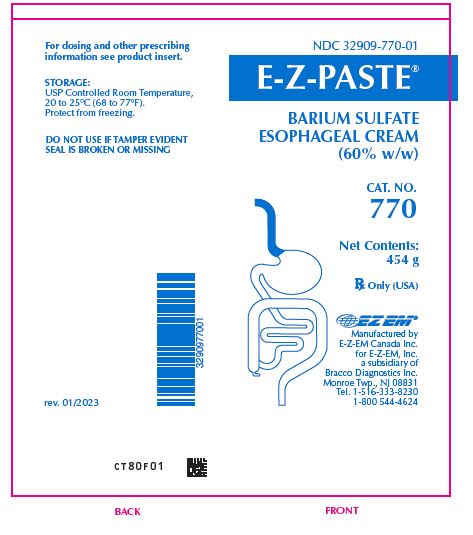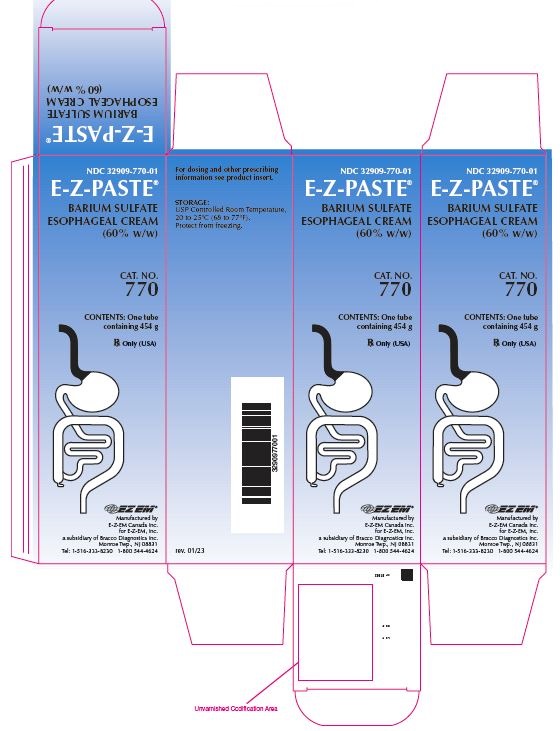E-Z-Paste: Package Insert / Prescribing Info
Package insert / product label
Generic name: barium sulfate
Dosage form: esophageal cream
Drug class: Non-iodinated contrast media
Medically reviewed by Drugs.com. Last updated on Jul 24, 2025.
On This Page
E-Z-Paste Description
E-Z-PASTE® Barium Sulfate Esophageal Cream (60% w/w) is a barium sulfate cream for oral administration. Each 100 g contains 60 g barium sulfate. Barium sulfate, due to its high molecular density is opaque to x-rays and, therefore, acts as a positive contrast agent for radiographic studies. The active ingredient is barium sulfate and its structural formula is BaSO4. Barium sulfate occurs as a fine, white, odorless, tasteless, bulky powder which is free from grittiness. Its aqueous suspensions are neutral to litmus. It is practically insoluble in water, solutions of acids and alkalies, and organic solvents.
E-Z-Paste - Clinical Pharmacology
Barium sulfate, due to its high molecular density is opaque to x-rays and, therefore, acts as a positive contrast agent for radiographic studies. Barium sulfate is biologically inert and therefore, is not absorbed or metabolized by the body, and is eliminated unchanged from the body.
Indications and Usage for E-Z-Paste
For use in single contrast radiography of the esophagus, pharynx, hypopharynx and for cardiac series.
Contraindications
This product should not be used in patients with known gastric or intestinal perforation or hypersensitivity to barium sulfate products.
Warnings
Rarely, severe allergic reactions of an anaphylactoid nature, have been reported following administration of barium sulfate contrast agents. Appropriately trained personnel and facilities should be available for emergency treatment of severe reactions and should remain available for at least 30 to 60 minutes following administration, since delayed reactions can occur.
Precautions
General
Diagnostic procedures which involve the use of radiopaque contrast agents should be carried out under the direction of personnel with the requisite training and with a thorough knowledge of the particular procedure to be performed. A history of bronchial asthma, atopy, as evidenced by hay fever and eczema, or a previous reaction to a contrast agent, warrant special attention. Caution should be exercised with the use of radiopaque media in severely debilitated patients and in those with marked hypertension or advanced cardiac disease.
Caution should be used during the administration of this product to patients with a history of food aspiration or to patients in whom integrity of the swallowing mechanism is unknown. If this product is aspirated into the larynx, further administration should be discontinued immediately.
After any barium study of the GI tract, it is important to rehydrate the patient as quickly as possible to prevent impaction of the bowel by barium sulfate. To prevent barium sulfate impaction in the bowel, the use of mild laxatives such as milk of magnesia or lactulose, following completion of the examination may also be required. These mild laxatives are recommended on a routine basis and in patients with a history of constipation unless contraindicated.
Use with caution with complete or nearly complete esophageal or gastric obstruction.
Information for Patients
Before administration of this product patients should be instructed to:
- Inform their physician if they are pregnant.
- Inform their physician if they are allergic to any drugs or food, or if they have had any prior reactions to barium sulfate products or other contrast agents used in x-ray procedures (see PRECAUTIONS-General).
- Inform their physician about any other medications they are currently taking.
Drug Interactions
The presence of barium sulfate formulations in the GI tract may alter the absorption of therapeutic agents taken concomitantly. In order to minimize any potential change in absorption, the separate administration of barium sulfate from that of other agents should be considered.
Adverse Reactions/Side Effects
Adverse reactions, such as nausea, vomiting, diarrhea and abdominal cramping, accompanying the use of barium sulfate formulations are infrequent and usually mild. Severe reactions (approximately 1 in 1,000,000) and fatalities (approximately 1 in 10,000,000) have occurred. Procedural complications are rare, but may include aspiration pneumonitis, barium sulfate impaction, granuloma formation, intravasation, embolization and peritonitis following intestinal perforation, vasovagal and syncopal episodes, and fatalities. It is of the utmost importance to be completely prepared to treat any such occurrence.
Related/similar drugs
ALLERGIC REACTIONS
Due to the increased likelihood of allergic reactions in atopic patients, it is important that a complete history of known and suspected allergies as well as allergic-like symptoms, e.g., rhinitis, bron-chial asthma, eczema and urticaria, must be obtained prior to any medical procedure utilizing these products. A mild allergic reaction would most likely include generalized pruritus, erythema or urticaria (approximately 1 in 250,000). Such reactions will generally respond to an antihistamine such as 50 mg of diphenhydramine or its equivalent. In the rarer, more serious reactions (approximately 1 in 1,000,000) laryngeal edema, bronchospasm or hypotension could develop. Severe reactions which may require emergency measures are often characterized by peripheral vasodilation, hypotension, reflex tachycardia, dyspnea, agitation, confusion and cyanosis progressing to unconsciousness. Treatment should be initiated immediately with 0.3 to 0.5 mL of 1:1000 epinephrine subcutaneously. If bronchospasm predominates, 0.25 to 0.50 grams of intravenous aminophylline should be given slowly. Appropriate vasopressors might be required. Adrenocorticosteroids, even if given intravenously, exert no significant effect on the acute allergic reactions for a few hours. The administration of these agents should not be regarded as emergency measures for the treatment of allergic reactions.
Apprehensive patients may develop weakness, pallor, tinnitus, diaphoresis and bradycardia following the administration of any diagnostic agent. Such reactions are usually non-allergic in nature and are best treated by having the patient lie flat for an additional 10 to 30 minutes under observation.
Overdosage
On rare occasions following repeated administration, severe stomach cramps, nausea, vomiting, diarrhea or constipation may occur. These are transitory in nature and are not considered serious. Symptoms may be treated according to currently accepted standards of medical care.
Storage and Handling
Store product at USP Controlled Room Temperature, 20 to 25°C (68 to 77°F). Protect from freezing.
| E-Z-PASTE
barium sulfate cream |
||||||||||||||||||||||||||||||
|
||||||||||||||||||||||||||||||
|
||||||||||||||||||||||||||||||
|
||||||||||||||||||||||||||||||
|
||||||||||||||||||||||||||||||
|
||||||||||||||||||||||||||||||
|
||||||||||||||||||||||||||||||
| Labeler - E-Z-EM Canada Inc (204211163) |
| Registrant - E-Z-EM, INC. (002041226) |
| Establishment | |||
| Name | Address | ID/FEI | Business Operations |
|---|---|---|---|
| E-Z-EM Canada Inc | 204211163 | ANALYSIS(32909-770) , MANUFACTURE(32909-770) , LABEL(32909-770) , PACK(32909-770) | |
More about E-Z Paste (barium sulfate)
- Compare alternatives
- Pricing & coupons
- Side effects
- Dosage information
- During pregnancy
- Drug class: non-iodinated contrast media
- Breastfeeding
Patient resources
Professional resources
Other brands
Entero VU, Liquid E-Z Paque, Readi-Cat, Tagitol V, ... +11 more


